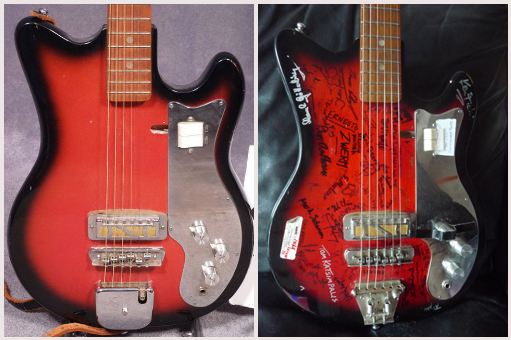How many of us preachers actually go to the Bible anymore? Now this question has nothing to do with Bible-based preaching. The question arises from a lack of attention I have noticed in my own sermon development to the materiality of the text.
To be honest, most of my sermon development takes place on my computer. With a few keystrokes I can access a pericope in its original language, complete with access to Brown-Driver-Briggs, Bauer-Arndt-Gingrich-Danker, and the Anchor Bible Dictionary—my trusted friends since seminary. I zip along in my exegetical work while my lexicons and Bibles collect dust on my bookshelf. I was struck recently about how the materiality of the Text might play a role in what emerges from my engagement with it.
I began to think about the materiality of the Text when I read this article in The New York Times about a recent pop culture phenomenon. The $100 Guitar Project began when a pair of musicians discovered an unlabeled guitar from the 1960s for sale on eBay for $100. What drew these artists to the guitar was it generic quality; it had no logo and its playability was in serious question. The guitar is strikingly un-noteworthy: it’s got a solid wood body painted black and red, an old-fashioned metal pickup, and multiple signs of wear. They weren’t even sure that it worked!
Nick Didkovsky, one of the progenitors of the project, describes his instant fascination with the guitar:
It was so generic. It had no brand on it. It was a mystery, with super retro vibes. One of the pickups was missing, and the other looked truly ancient — like a radio in a black-and-white movie, with electric bolts coming out of the speaker. It was like a generic token, the kind of electric guitars you drew in notebooks when you were 8 years old.
Thus the $100 Dollar Guitar Project was born. The concept behind the project was simple: pass this guitar along to a variety of artists representing a diversity of musical genres and see what kinds of music emerge. Each participant would have the guitar for only one week, during which time she or he needed to prepare and record an original song (you can see why this article made me think about preaching, for is that not our weekly challenge?).
Didkovsky and his partner in this endeavor, Chuck O’Meara, managed to enlist over 65 players, each recording an original piece with the guitar before signing it and passing it along to the next musician. All in all, the guitar has traveled over 30,000 miles and features original riffs from musicians ranging from alternative rock guitarist Nels Cline of Wilco to David Starobin, a classical guitarist who teaches at the Manhattan School of Music.
The project went viral and led NPR correspondent Joel Rose to sit down with Didkovsky and O’Meara to discuss the outcome of the project in this issue of Morning Edition. O’Meara rightly observes that the “range of sounds that people have pulled out of this instrument is really quite surprising.” On the project website you can view a series of short YouTube clips posted by some of the artists. The results are indeed astounding.
I love the 80s metal vibe that Marty Carlson produced, which contrasts markedly from the hauntingly surreal, Cagesque song entitled “I Hate Zero Crossings” performed by Hans Tammen. My favorite video is the one posted by Nick Didkovsky, which you can find embedded here.
I like it so much because it provides insight into the creative license initiated by this $100 generic guitar.
When I learned about the $100 Guitar Project I couldn’t help but think about the material quality of the Bible and the plurality of voices that have found new modes of expression from its deep reservoir. As I write this article, I am thumbing through a worn King James Bible that belonged to my grandfather. The text is yellowed with age and the pages are so thin that it’s difficult to separate them. Also on my desk rests a shiny new copy of the freshly minted Common English Bible. There are no marks in this version, no dog-eared pages, and no margin notes. I can imagine two totally different sermons emerging from each of these texts.
Next time I preach, rather than turning to biblos.com or launching my Logos Bible app on my iPad, I’m going to attend better to the materiality of the text and see where it leads me. Bearing in mind Marshall McLuhan’s oft-cited adage — “The medium is the message” — I am excited to see how the material medium of the text shapes my engagement with its message.

